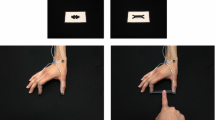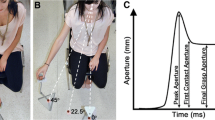Abstract
When an individual grasps a physical object, the visuomotor system is able to specify grip aperture via absolute visual information. In contrast, grasping to a location previously occupied by an object (i.e., pantomime-grasping) results in the specification of grip aperture via relative visual information. The basis for the dissociable visual codes is thought to reflect that pantomime-grasping is a perception-based task. It is, however, important to recognize that grasping a physical object and pantomime-grasping differ not only in terms of their visuospatial properties but also with respect to the availability of haptic feedback: Grasping a physical object provides haptic cues derived from touching the object, whereas no such feedback is available in a traditional pantomime-grasping task. As such, we examined whether haptic feedback influences the information supporting a pantomime-grasp performed after a 1000-ms visual delay. Participants completed responses in each of the three tasks: (1) grasping a physical object, (2) traditional pantomime-grasping wherein the to-be-grasped object was removed from the grasping environment and (3) pantomime-grasping wherein the experimenter placed the object between participants’ thumb and forefinger once they had completed their response (i.e., pantomime-grasping with haptic feedback). Just-noticeable-difference (JND) scores were computed to determine whether responses adhered to or violated the psychophysical (i.e., relative) principles of Weber’s law. JNDs for the traditional pantomime-grasping task adhered to Weber’s law, whereas JNDs for grasping a physical object and for pantomime-grasping with haptic feedback violated the law. Thus, we propose that convergent visual and haptic cues support the absolute specification of object size in a pantomime-grasping task. Furthermore, our results highlight the important role of multisensory cue integration in a target-defined grasping task.





Similar content being viewed by others
Notes
Smeets and Brenner (2008) contend that grasping violates Weber’s law because the visuomotor system computes grasp points rather than the size (or magnitude) of a to-be-grasped object. It is, however, important to note that pantomime-grasping (Holmes et al. 2013) and grasping a 2D object (Holmes and Heath 2013) violate Weber’s law—a result providing some evidence that the size of a target object is used to specify grip aperture. As such, the position adopted in the present study is that target size information is used, in part, to specify grasping. Of course, we recognize the basis of Smeets and Brenner’s comments and therefore direct the reader to the aforementioned authors’ target article (Smeets and Brenner 1999) that provides a lively debate and outline of the divergent views regarding whether object size or grasp point information supports aperture shaping.
DF is an extensively studied individual with bilateral lesions to her lateral occipital cortex (James et al. 2003). As a result of her lesions, DF has a persistent deficit in visual form perception but demonstrates preserved visuomotor abilities. DF’s preserved visuomotor abilities have been attributed to her intact dorsal visual pathway (for recent review see Goodale and Milner 2013).
Mechanoreceptor-derived (i.e., tactile) cues associated with touching an object or the surface on which it rests serve as an additional source of haptic feedback. In previous work (Davarpanah Jazi and Heath 2014; Davarpanah Jazi et al. 2015) as well as the current study, we note that such cues do not influence the nature of the information mediating visually or tactile-defined grasping (but see Whitwell et al. 2014). Instead, our work demonstrates that the proprioceptive component of haptic feedback supports the absolute specification of object size.
For the PH+ condition, we examined whether the size of the target object on trial N-1 influenced PGA or JND values for a current trial (i.e., trial N)—an approach matching a number of pro- and antisaccade task-switching experiments performed by our group (e.g., DeSimone et al. 2014; Weiler and Heath 2014). Results showed that preceding target object size did not influence PGAs or JNDs for a current trial (Fs < 1).
References
Arbib MA (1985) Schemas for the temporal organization of behaviour. Hum Neurobiol 4:63–72
Bingham G, Coats R, Mon-Williams M (2007) Natural prehension in trials without haptic feedback but only when calibration is allowed. Neuropsychologia 45:288–294
Brainard DH (1997) The psychophysics toolbox. Spat Vis 10:433–436
Cavina-Pratesi C, Kuhn G, Ietswaart M, Milner AD (2011) The magic grasp: motor expertise in deception. PLoS One 6:e16568
Christiansen JH, Grünbaum Christensen J, Kyllingsbæk S. T (2014) A common representation of spatial features drives action and perception: grasping and judging object features within trials. PLoS One 9:e94744
Cumming G (2013) Understanding the new statistics: effect sizes, confidence intervals, and meta-analysis. Routledge, New York
Davarpanah Jazi S, Heath M (2014) Weber’s law in tactile grasping and manual estimation: feedback-dependent evidence for functionally distinct processing streams. Brain Cogn 86:32–41
Davarpanah Jazi S, Hosang S, Heath M (2015) Memory delay and haptic feedback influence the dissociation of tactile cues for perception and action. Neuropsychologia (in press)
Desimone JC, Weiler J, Aber GS, Heath M (2014) The unidirectional prosaccade switch-cost: correct and error antisaccades differentially influence the planning times for subsequent prosaccades. Vis Res 96C:17–24
Dijkerman HC, de Haan EH (2007) Somatosensory processes subserving perception and action. Behav Brain Sci 30:189–201 (discussion 201–239)
Elliott D, Madalena J (1987) The influence of premovement visual information on manual aiming. Q J Exp Psychol A 39:541–559
Ernst MO, Banks MS (2002) Humans integrate visual and haptic information in a statistically optimal fashion. Nature 415:429–433
Fukui T, Inui T (2013) How vision affects kinematic properties of pantomimed prehension movements. Front Psychol 4:44
Ganel T, Chajut E, Algom D (2008a) Visual coding for action violates fundamental psychophysical principles. Curr Biol 18:R599–R601
Ganel T, Chajut E, Tanzer M, Algom D (2008b) Response: When does grasping escape Weber’s law? Curr Biol 18:R1090–R1091
Glover S (2004) Separate visual representations in the planning and control of action. Behav Brain Sci 27:3–24 discussion 24–78
Goodale MA, Milner AD (1992) Separate visual pathways for perception and action. Trends Neurosci 15:20–25
Goodale M, Milner D (2013) Sight unseen: an exploration of conscious and unconscious vision. Oxford University Press, Oxford
Goodale MA, Jakobson LS, Keillor JM (1994) Differences in the visual control of pantomimed and natural grasping movements. Neuropsychologia 32:1159–1178
Heath M, Neely K, Krigolson O, Binsted G (2010) Memory-guided reaching: what the visuomotor system knows and how long it knows it. In: Elliott D, Khan M (eds) Vision and goal-directed reaching: neurobehavioral perspectives. Human Kinetics, Champaign, pp 79–96
Heath M, Mulla A, Holmes SA, Smuskowitz LR (2011) The visual coding of grip aperture shows an early but not late adherence to Weber’s law. Neurosci Lett 490:200–204
Heath M, Holmes SA, Mulla A, Binsted G (2012) Grasping time does not influence the early adherence of aperture shaping to Weber’s law. Front Hum Neurosci 6:e332
Herzfeld DJ, Shadmehr R (2014) Motor variability is not noise, but grist for the learning mill. Nat Neurosci 17:149–150
Hesse C, Schenk T (2014) Delayed action does not always require the ventral stream: a study on a patient with visual form agnosia. Cortex 54:77–91
Holmes SA, Heath M (2013) Goal-directed grasping: the dimensional properties of an object influence the nature of the visual information mediating aperture shaping. Brain Cogn 82:18–24
Holmes SA, Mulla A, Binsted G, Heath M (2011) Visually and memory-guided grasping: aperture shaping exhibits a time-dependent scaling to Weber’s law. Vis Res 51:1941–1948
Holmes SA, Lohmus J, McKinnon S, Mulla A, Heath M (2013) Distinct visual cues mediate aperture shaping for grasping and pantomime-grasping tasks. J Mot Behav 45:431–439
James TW, Culham J, Humphrey GK, Milner AD, Goodale MA (2003) Ventral occipital lesions impair object recognition but not object-directed grasping: an fMRI study. Brain 126:2463–2475
Jeannerod M (1984) The timing of natural prehension movements. J Mot Behav 16:235–254
Lederman SJ, Klatzky RL (2009) Haptic perception: a tutorial. Atten Percept Psychophys 71:1439–1459
Liepmann H (1905/1980) The left hemisphere and action (Translation from Münchener Medizinische Wochenschriff 1905, 48–49) Translations from Liepmann’s essays on apraxia. Research Bulletin 506, Department of Psychology, University of Western Ontario, London
Loftus GR, Masson ME (1994) Using confidence intervals in within-subject designs. Psychon Bull Rev 1:476–490
Marks LE, Algom D (1998) Psychophysical scaling. In: Birnbaum MK (ed) Measurement, judgment, and decision making. Academic Press, San Diego, pp 81–178
Marteniuk RG, MacKenzie CL, Jeannerod M, Athenes S, Dugas C (1987) Constraints on human arm movement trajectories. Can J Psychol 41:365–378
Meyer DE, Abrams RA, Kornblum S, Wright CE, Smith JE (1988) Optimality in human motor performance: ideal control of rapid aimed movements. Psychol Rev 95:340–370
Milner AD, Ganel T, Goodale MA (2012) Does grasping in patient D.F. depend on vision? Trends Cogn Sci 16:256–257 discussion 258–259
Pettypiece CE, Goodale MA, Culham JC (2010) Integration of haptic and visual size cues in perception and action revealed through cross-modal conflict. Exp Brain Res 201:863–873
Proteau L, Blandin Y, Alain C, Dorion A (1994) The effects of the amount and variability of practice on the learning of a multi-segmented motor task. Acta Psychol (Amst) 85:61–74
Schenk T (2012a) No dissociation between perception and action in patient DF when haptic feedback is withdrawn. J Neurosci 32:2013–2017
Schenk T (2012b) Response to Milner et al.: grasping uses vision and haptic feedback. Trends Cogn Sci 16:258–259
Schmidt RA, Zelaznik H, Hawkins B, Frank JS, Quinn JT (1979) Motor-output variability: a theory for the accuracy of rapid motor acts. Psychol Rev 47:415–451
Smeets JB, Brenner E (1999) A new view on grasping. Mot Control 3:237–271
Smeets JB, Brenner E (2008) Grasping Weber’s law. Curr Biol 18:R1089–R1090
Wallace SA, Weeks DL (1988) Temporal constraints in the control of prehensile movement. J Mot Behav 20:81–105
Weiler J, Heath M (2014) Oculomotor task-switching: alternating from a nonstandard to a standard response yields the unidirectional prosaccade switch-cost. J Neurophysiol 112:2176–2188
Westwood DA, Chapman CD, Roy EA (2000) Pantomimed actions may be controlled by the ventral visual stream. Exp Brain Res 130:545–548
Whitwell RL, Buckingham G (2013) Reframing the action and perception dissociation in DF: Haptics matters, but how? J Neurophysiol 109:621–624
Whitwell RL, Milner AD, Cavina-Pratesi C, Byrne CM, Goodale MA (2014) DF’s visual brain in action: the role of tactile cues. Neuropsychologia 55:41–50
Wing AM, Turton A, Fraser C (1986) Grasp size and accuracy of approach in reaching. J Mot Behav 18:245–260
Wu HG, Miyamoto YR, Gonzalez Castro LN, Ölveczky BP, Smith MA (2014) Temporal structure of motor variability is dynamically regulated and predicts motor learning ability. Nat Neurosci 17:312–321
Acknowledgments
This study was supported by a Discovery Grant from the Natural Sciences and Engineering Research Council of Canada and Faculty Scholar and Academic Development Fund Awards from the University of Western Ontario.
Author information
Authors and Affiliations
Corresponding author
Rights and permissions
About this article
Cite this article
Davarpanah Jazi, S., Yau, M., Westwood, D.A. et al. Pantomime-grasping: the ‘return’ of haptic feedback supports the absolute specification of object size. Exp Brain Res 233, 2029–2040 (2015). https://doi.org/10.1007/s00221-015-4274-0
Received:
Accepted:
Published:
Issue Date:
DOI: https://doi.org/10.1007/s00221-015-4274-0




